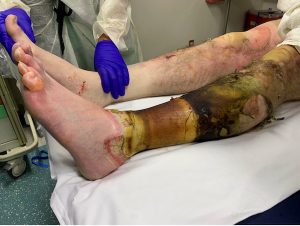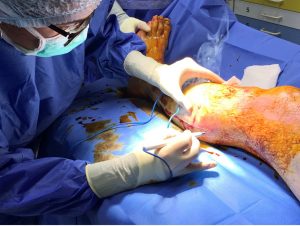Annamalai Nadarajan Jr., MD
Michael L. Sternberg, MD FACEP FAAEM
University of South Alabama Health
Chief Complaint:
“My legs are burnt”
History of Present Illness:
A 55 yo CM with a history of seizure disorder presents to the emergency room by EMS status post sustaining burns to his lower extremities. The patient apparently suffered a seizure with loss of consciousness while unaccompanied and tending to a trash fire. Patient regained sensorium to find lower extremity burns.
Pertinent Physical Exam:
Vital Signs: BP 169/107, P 130, RR 18, T 36.6°C
General: Alert, mod distress, anxious
Skin: Second and Third degree (full thickness) burns to lower extremities as noted (Figure 1). Skin taught, inelastic, charred black with insensate regions, and circumferential to left lower leg knee to ankle. Left foot, edematous, cyanotic, with visible in vessel coagulation, cool to touch with non-palpable pulse.
Labs:
Non contributory
Questions:
- What is the most feared complication of circumferential extremity burns?
- What emergency treatment is indicated?
Answers:
- Compartment syndrome. Confirmed by clinical findings of neurovascular compromise distal to the burn or direct measurement by pressure manometry.
- Escharotomy
Discussion:
Circumferential burns to extremities can lead to compartment syndrome, which is characterized by neurovascular compromise distal to the circumferential burn. The classical 6 “P’s” of compartment syndrome are pain, pallor (pale skin tone), paresthesia, pulselessness, paralysis, and poikilothermia, and they classically occur in that order. The 3 “A’s” of compartment syndrome are increasing anxiety, increasing agitation, and increasing analgesic requirement. These are important clinical signs that need to frequent assessed for at regular intervals in patients with circumferential extremity burns.
Compartment syndrome can be clinically diagnosed with the above mentioned signs on physical examination or compartment pressures can be measured directly using a Stryker intercompartmental pressure monitor or by using an arterial line transducer. Normal compartment pressures are less than 10 mmHg, pressures up to 20mm Hg can be tolerated without significant damage to tissues, and cell death typically begins to occur after compartment pressures are greater than 30 mmHg. “Delta pressure” is also a useful tool in determining of compartment syndrome is present
Delta pressure = [Diastolic Blood Pressure] – [Compartment Pressure]
A delta pressure < 30mmHg is suggestive of compartment syndrome.
The primary method to treat compartment syndrome is to perform an escharotomy (Figure 2) to relieve the pressure being exerted on neurovascular structure within the compartment. Local anesthetic can be infiltrated in unburn skin into which the escharotomy will extend or sedation can be used, escharotomy typically does not require general anesthesia. A scalpel or cutting diathermy (cautery device) can be used to perform the escharotomy. Cauterization diathermy is used to control bleeding after making escharotomy incisions.

Figure 1. Circumferential burn of left lower extremity with color change of skin distal to burn

Figure 2. Emergent left lower extremity escharotomy
Journal References:
- Zhang L, Hughes PG. Escharotomy. [Updated 2020 Jul 15]. In: StatPearls [Internet]. Treasure Island (FL): StatPearls Publishing; 2020 Jan-.
- Boccara D, Lavocat R, Soussi S, Legrand M, Chaouat M, Mebazaa A, Mimoun M, Blet A, Serror K. Pressure guided surgery of compartment syndrome of the limbs in burn patients. Ann Burns Fire Disasters. 2017 Sep 30;30(3):193-197. PMID: 29849522; PMCID: PMC5946744.
